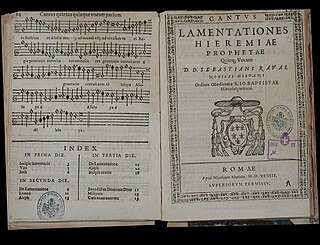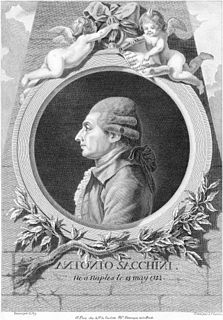Related Research Articles

Adriano Banchieri was an Italian composer, music theorist, organist and poet of the late Renaissance and early Baroque eras. He founded the Accademia dei Floridi in Bologna.
Andrea Gabrieli was an Italian composer and organist of the late Renaissance. The uncle of the somewhat more famous Giovanni Gabrieli, he was the first internationally renowned member of the Venetian School of composers, and was extremely influential in spreading the Venetian style in Italy as well as in Germany.
Giaches de Wert was a Franco-Flemish composer of the late Renaissance, active in Italy. Intimately connected with the progressive musical center of Ferrara, he was one of the leaders in developing the style of the late Renaissance madrigal. He was one of the most influential of late sixteenth-century madrigal composers, particularly on Claudio Monteverdi, and his later music was formative on the development of music of the early Baroque era.
Charles-Antoine Campion, italianized as Carlo Antonio Campioni was a French-Italian composer who was born in Lorraine, France. He was a prolific composer and represented a link between Baroque compositional methods and those of the Classical style.

Barbara Strozzi was an Italian composer and singer of the Baroque Period. During her lifetime, Strozzi published eight volumes of her own music, and had more music in print than any other composer of the era. This was achieved without any support from the Church and with no consistent patronage from the nobility.

Giovanni Legrenzi was an Italian composer of opera, vocal and instrumental music, and organist, of the Baroque era. He was one of the most prominent composers in Venice in the late 17th century, and extremely influential in the development of late Baroque idioms across northern Italy.

Sebastián Raval was a Spanish composer of vocal and instrumental music. Born in Cartagena, he served as a soldier of the Army of Flanders in Flanders and Sicily. He joined the order of St. John of Jerusalem after being wounded in the siege of Maastricht.
Giorgio Pacchioni is an Italian performer, professor, and composer.

Antonio Maria Gasparo Gioacchino Sacchini was an Italian composer, best known for his operas.
Giovanni Girolamo Kapsperger was an Austrian-Italian virtuoso performer and composer of the early Baroque period. A prolific and highly original composer, Kapsberger is chiefly remembered today for his lute and theorbo (chitarrone) music, which was seminal in the development of these as solo instruments.
The year 1614 in music involved some significant musical events.
Simone Molinaro was a composer of the late Renaissance in Italy. He was especially renowned for his lute music.

Stefano de Maza Gatto also known as Stefano Felis, was a Neapolitan Italian composer of the Renaissance, and the collaborator and probable teacher of composer Pomponio Nenna. He composed madrigals, sacred motets, and choral settings of the Mass.
Camillo Cortellini was an Italian composer, singer, and violinist.
Antonio Il Verso was an Italian composer.
Agostino Agresta was a Neapolitan composer working at the beginning of the 17th century, who can be seen as having been strongly influenced by Carlo Gesualdo. Agresta's only known surviving works are unaccompanied madrigals, including a complete book of six-voice pieces.

StefanoBernardi, also known as "il Moretto", was an Italian priest, composer and music theorist. Born in Verona and maestro di cappella at the Verona Cathedral from 1611 to 1622, he later moved to Salzburg, where he was responsible for the music at the Salzburg Cathedral and composed a Te Deum for 12 choirs performed at the cathedral's consecration in 1628.

Charles d'Helfer (1598–1661) was a French baroque composer and maître de musique at Soissons Cathedral. His masses follow a strict one syllable per note style.

Alessandro Felici was an Italian composer and violinist, not to be confused with his contemporary, Roman composer Felice Alessandri.
References
- ↑ Iain Fenlon Early Music History: Studies in Medieval and Early Modern Music p 124 2009 "Finally, the composer listed as 'P. Balsamino' must be Simone Balsamino; his only known musical composition is that listed in the table, the Aminta musicale."
- ↑ Sibyl Marcuse A survey of musical instruments Harper & Row, 1975
- ↑ Balsamino, Simone, Perla, tragicomedia in rima libera di Simone Balsamino, dedicata all'illustrissimo marchese De La Rovere con privilegio, in Venetia, appresso Niccolo Moretti 1596.